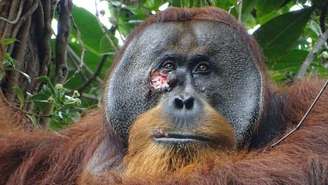An orangutan from Sumatra, Indonesia, treats itself using a paste made from plants to heal a large gash on its cheek, scientists said.
This is the first time that a creature in nature has been recorded treating a wound with a medicinal plant.
After researchers saw Rakos applying plant poultices to his face, the wound closed and healed within a month.
Scientists say this behavior may come from a common ancestor between humans and great apes.
“They are our closest relatives and this once again points to the similarities between us and them,” said biologist Isabella Lommer, from the Max Planck Institute in Germany, and co-author of the research. “We are more similar than different.”
A research team in Indonesia’s Gunung Leuser National Park spotted Rakus with a large gash on his cheek in June 2022.
They believe the animal was injured while fighting with orangutan rivals because it made tearful cries, known as “long calls,” days before the injury was identified.
The team then watched Rakos chew the stem and leaves of acar kuning, an anti-inflammatory and antibacterial plant also used locally to treat malaria and diabetes.
He repeatedly applied the liquid to his cheek for seven minutes. Rakos then spread the chewed leaves over his wound until it was completely covered. Continue feeding on the plant for more than 30 minutes.
The paste and leaves seemed to have worked their magic, as researchers found no sign of infection and the wound closed within five days.
A month later, Rakos was completely healed.
“He applied the paste repeatedly, and then he also applied more solid plant material from the plant. The whole process took a long time – which is why we think he applied it deliberately,” explains Loomer.
The researchers also saw Rakos resting much longer than usual – more than half the day – suggesting that he was trying to recover after the injury.
Scientists already knew that great apes use medicine to try to treat themselves.
In the 1960s, biologist Jane Goodall saw whole leaves in the feces of chimpanzees, and others have documented seeing great apes ingest leaves with medicinal properties.
But they had never seen a wild animal apply a plant to a wound.
Loomer says it’s possible this is the first time Rakos has received this type of treatment.
“He may have accidentally touched the wound with his finger containing the plant. Then, when the plant destroyed the powerful pain-relieving substances, he may have felt immediate relief, causing him to apply it again and again.” .
Or he may have learned the method by observing other forest animals in his group.
Researchers will now look more closely at other orangutans to see if they can discover the same medicinal abilities demonstrated by Rakus.
“I think in the coming years we will discover more behaviors and abilities that are very similar to humans,” she suggests.
The research is published in the scientific journal Scientific Reports.



![[VÍDEO] Elton John’s final show in the UK has the crowd moving](https://www.lodivalleynews.com/wp-content/uploads/2023/06/Elton-John-1-690x600.jpg)


More Stories
The Director of Ibict receives the Coordinator of CESU-PI – Brazilian Institute for Information in Science and Technology
A doctor who spreads fake news about breast cancer is registered with the CRM of Minas
The program offers scholarships to women in the field of science and technology